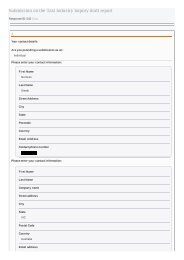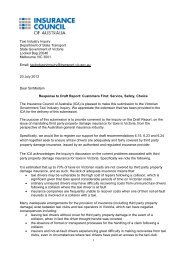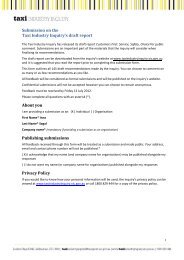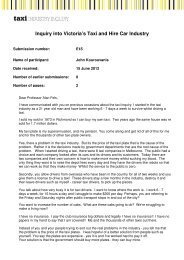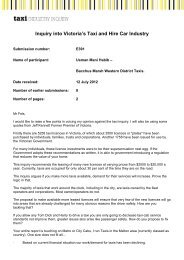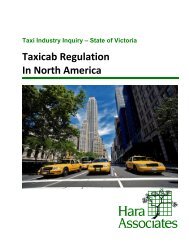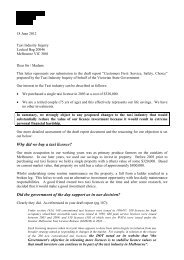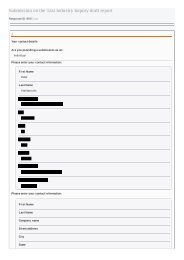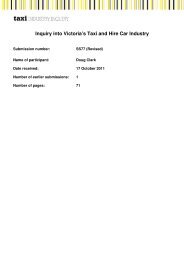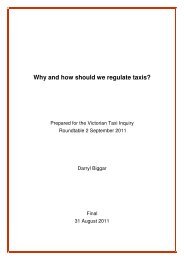Part D â Understanding and improving industry performance (PDF ...
Part D â Understanding and improving industry performance (PDF ...
Part D â Understanding and improving industry performance (PDF ...
Create successful ePaper yourself
Turn your PDF publications into a flip-book with our unique Google optimized e-Paper software.
10.2.2. Detriments from restrictions<br />
on licences<br />
Quantitative restrictions on entry have obvious effects<br />
on market structure: they directly limit how many firms<br />
can enter the market. These restrictions allow holders of<br />
licences to earn profits from the supply of taxi or hire car<br />
services. These profits may be earned either by operating<br />
the taxi or hire car or, as discussed below, by assigning<br />
the taxi licence to an operator.<br />
The restrictions are costly for consumers because:<br />
1. Prices are higher than necessary to provide the<br />
service (as the assignment costs, which are real costs<br />
for taxi operators, are built into regulated fares)<br />
2. Restrictions exacerbate problems of meeting dem<strong>and</strong><br />
at peak times<br />
3. Restrictions limit service innovation<br />
4. Restrictions impose a significant regulatory burden<br />
<strong>and</strong> create the risk of the licensing authority choosing<br />
the wrong price <strong>and</strong> quality combination.<br />
Further detriments result from related regulations that<br />
are, to some extent, a function of the restricted licensing<br />
regime. This includes zoning regulations <strong>and</strong> restrictions<br />
on the operation of hire cars.<br />
The nature <strong>and</strong> significance of these detriments are<br />
discussed in the following four sections.<br />
1. Effects of licence prices on fares<br />
In metropolitan Melbourne, the most obvious symptom<br />
of the current supply restrictions is the price (nearly<br />
$500,000) at which taxi licences trade <strong>and</strong> the value<br />
attached to licence assignments (around $30,000 per<br />
year). Assignment values reflect annual profits that can be<br />
earned in operating a taxi, while licence values reflect the<br />
discounted sum of annual profits that may be earned in<br />
operating a taxi. 10<br />
The fact that assignments represent <strong>industry</strong> profits<br />
is not universally accepted within the <strong>industry</strong>. The<br />
inquiry underst<strong>and</strong>s this is because assignments do not<br />
necessarily track <strong>industry</strong> profitability smoothly. The ESC<br />
has described this as assignments showing a degree of<br />
‘price stickiness’ – noting, for example, that there was<br />
limited downward pressure on assignment fees in late<br />
2007 even though LPG prices were rising. 11<br />
Further, assignment prices have risen over the past few<br />
years even though there have been no fare increases<br />
<strong>and</strong> there have been cost increases relating to network<br />
service provider (NSP) fees <strong>and</strong> insurance. Some<br />
submitters put this down to “competition within the<br />
brokerage sector of the <strong>industry</strong>”, with “prices being<br />
artificially manipulated…to the benefit of licence owners,<br />
taxi brokers <strong>and</strong> other key <strong>industry</strong> players with a vested<br />
interest in ensuring that prices are retained at the current<br />
high levels”. 12 The VTD also comments that it is difficult to<br />
underst<strong>and</strong> why the dem<strong>and</strong> for licence assignments is<br />
so high given the cost pressures on operators. 13<br />
The inquiry accepts that there is some evidence of inefficiency<br />
in the assignment of licences. This is discussed further below.<br />
Nonetheless, the inquiry’s view is that in the medium to longer<br />
term, it is not possible for assignment values to be totally<br />
divorced from the profitability of operating a taxi licence.<br />
The fact that more <strong>and</strong> more licences are being assigned<br />
also strongly suggests that operators are able to make the<br />
profits necessary to justify paying the assignment fee.<br />
The reason that assignment fees create higher prices for<br />
consumers is that these fees are recovered from fares:<br />
although they are technically a rent <strong>and</strong> not a cost, they<br />
form part of the cost base estimated by the ESC to<br />
calculate efficient taxi fares. The ESC notes that:<br />
Assignment fees represent a significant proportion of<br />
taxi revenue. For an average 7.7 km journey the<br />
average base fare in Victoria is approximately $17.35,<br />
of which assignment fees account for $3.05, or 17<br />
per cent. 14<br />
Treating these economic rents as costs means that, other<br />
things being equal, fares are higher than they would be in<br />
a market where licences had no intrinsic value. 15<br />
It is important to recognise that this source of<br />
inefficiency is a direct result of licence restrictions. In<br />
a market without licence restrictions (<strong>and</strong> non<br />
prohibitive licence fees), there would be no<br />
assignment fees as each operator would also be a<br />
licence holder, <strong>and</strong> operators would be free to earn<br />
economic profits that correlate with their level of input<br />
into the <strong>industry</strong>. Hence, restricting licences creates a<br />
transfer of economic profit away from operators, <strong>and</strong><br />
licence holders receive this in the form of an<br />
economic rent. 16<br />
10 A number of submissions noted that the Victorian Government is now<br />
the largest owner of taxi-cab licences in Victoria. In particular, the<br />
Government leases licences – notably, 600 ‘green top’ peak service<br />
taxis <strong>and</strong> 530 licences released in 2011 under the Greater Melbourne<br />
Taxi Licence Release<br />
11 ESC Staff Paper, Submission to the Taxi Industry Inquiry, SS151, p.31<br />
12 Ambassador Taxis, Taxi link <strong>and</strong> Cabways, Joint submission to the<br />
Taxi Industry Inquiry, SS233, p.29<br />
13 VTD, Op. Cit., p.26<br />
14 ESC Staff Paper, Op.Cit., p.27<br />
15 It is possible that other things may not be equal. In particular, lowering<br />
fares with no increase in supply will increase waiting times <strong>and</strong> may<br />
therefore decrease dem<strong>and</strong>. The gains to consumers from reducing<br />
fares on their own may not be as high as the assignment profits<br />
currently earned<br />
16 ESC Staff Paper, Op. Cit., p.32<br />
<strong>Underst<strong>and</strong>ing</strong> <strong>industry</strong> <strong>performance</strong> CUSTOMERS FIRST 183




